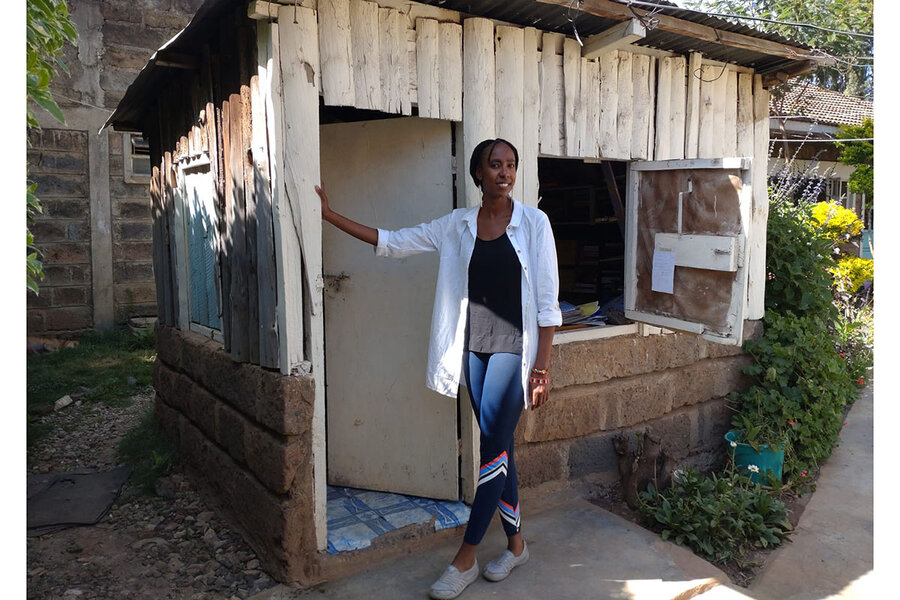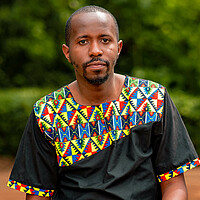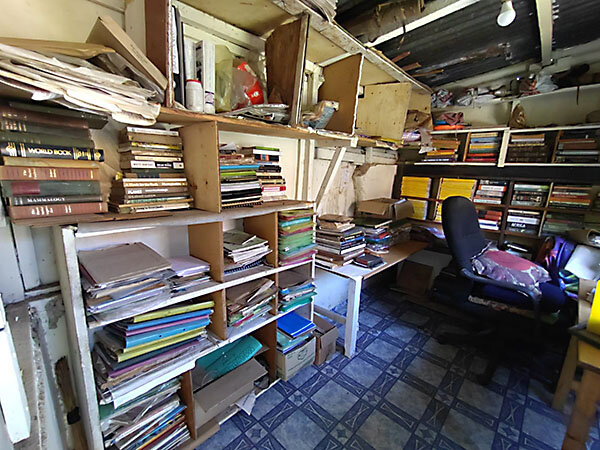How a ‘headstrong historian’ is rewriting Kenya’s colonial history
Loading...
| NAIROBI, Kenya
Chao Tayiana Maina was a university undergraduate when she stumbled upon the abandoned Voi railway station, a single-story red-brick building that was once a key military transport point for British colonialists.
Fascinated by the station’s beauty, and the wider history of the colonial-era Kenya-Uganda railway, she began documenting it all. “Save the Railway” now lives on as an interactive website featuring 50 stations. That initiative launched Ms. Tayiana’s mission to use technology to unearth hidden or suppressed history – and its injustices.
Why We Wrote This
A story focused onIn Kenya, a self-described “headstrong historian” is unearthing suppressed historical narratives. Her quest shows how technology, amplifying rarely heard local perspectives, can ignite a deeper connection with the past.
Digital heritage – the use of digital technology to present, preserve, and understand cultural or natural heritage – is a small but growing field in Africa. Recent initiatives run the gamut from archaeology to conservation projects. And during the COVID-19 pandemic, cultural institutions began looking to digital solutions to keep afloat.
Such homegrown initiatives are “incredibly important” because organizations from North America or Europe have long held financial and institutional power over Africa’s cultural heritage, says Colleen Morgan, a digital archaeology and heritage lecturer at the University of York in England.
“There is a lot of power in reclaiming agency over your own past,” Ms. Tayiana says. “Having someone else define who you are … is very detrimental to how you see yourself.”
Chao Tayiana Maina was doing digital heritage work before she even knew it had a name.
Trying to settle into university in Voi, a Kenyan town 215 miles from her home, she took to going on walks. One day, she stumbled upon Voi railway station, a single-story red-brick building that was once a key military transport point for British colonialists during the World War I.
Fascinated by the station’s beauty, and the wider history of the colonial-era Kenya-Uganda railway, she began thinking of how to preserve the memory of the stations. After more than a century of use, the railway was in decline. And with Kenya planning a new Chinese-built railway, some old stations were set to be demolished.
Why We Wrote This
A story focused onIn Kenya, a self-described “headstrong historian” is unearthing suppressed historical narratives. Her quest shows how technology, amplifying rarely heard local perspectives, can ignite a deeper connection with the past.
Over four years, largely through the financial and moral support of family and friends, Ms. Tayiana documented 50 sites – taking photos, making videos, and carrying out interviews with Kenyans who had worked or lived around the stations. “Save the Railway” first opened at a Nairobi gallery in 2016 and now lives on as a website with an interactive map.
That project was the beginning of Ms. Tayiana’s mission to use technology to unearth hidden or suppressed history – and its injustices – making it accessible to a wide audience.
Across Africa, British colonialists romanticized the railway – whose deadly construction they oversaw through indentured Indian and African labor – with adventure narratives across “exotic” lands. Ms. Tayiana wanted to show, through her interviews, both the joy and the pain the railway represented for ordinary Kenyans. They had used it to carry children to school or produce to market, but their rulers had used it to carry thousands of anti-colonial liberation fighters to detention camps in carriages with barred windows and barbed wire.
Kenya was under crushing British rule from 1895 to 1963. But much of the East African country’s colonial history was written by the same colonial powers that centered narratives glorifying and whitewashing their rule. As the world increasingly unearths the horrors of British empire and colonialism, young Kenyans are working to change the narrative and recount a more balanced version of Kenya’s colonial history.
“There is a lot of power in reclaiming agency over your own past,” Ms. Tayiana says. “Having someone else define who you are … is very detrimental to how you see yourself.”
Bringing African Value
On a recent Friday night, dozens gathered on a Nairobi skyscraper rooftop to hear Ms. Tayiana talk about Africa’s astronomical heritage at an event called “Space for Culture.” Speaking under a cloudy sky, she asked why African knowledge is so poorly represented in the global field, even though many Africans historically have incorporated complex astronomical observations into their lives.
Next, she played a video interview with a man from Kenya’s semi-nomadic Samburu pastoralist community, who traditionally live in vast drylands of northern Kenya. Without hesitation, the elder described and named several celestial features – Nkakwa for the Milky Way, and Ngurikinyeji for Orion’s Belt.
“It helps to build more confidence in ourselves as Africans and realize that we’ve always had agency and knowledge of what was happening around us,” says Karen Mwangi, who sat captivated through the talk. “We may not have written about it the same way other communities did, but we still knew about it, and it was something that we interacted with.”
Meanwhile, the value of African astronomy has become increasingly apparent in recent years. Last year, the Southern African Large Telescope in South Africa, one of the largest telescopes in the Southern Hemisphere, contributed to the discovery of a system of four stars orbiting each other.
Digital heritage – the use of digital technology to present, preserve, and understand cultural or natural heritage – is a small but growing field in Africa.
Recent projects run the gamut from digital archaeology to conservation projects. And, during the COVID-19 pandemic, the field expanded further as cultural institutions looked to digital solutions to keep afloat.
Homegrown initiatives are “incredibly important” because organizations from North America or Europe have long held financial and institutional power over Africa’s cultural heritage, says Colleen Morgan, a senior lecturer in digital archaeology and heritage at the University of York in England. While such organizations can be well intentioned, their work tends to extract local and Indigenous knowledge to disseminate as they see fit, without making the data or tools available to local contributors, she adds.
Growing up in the Rift Valley town of Ngong, Ms. Tayiana devoured books, maps, and old photographs in her grandparents’ rich home archives. By the time she was a math and computer science undergraduate at the Jomo Kenyatta University of Agriculture and Technology, she was running a blog curating historical articles about Kenya.
“I consider myself a historian by passion,” she says. “I’ve always felt that I’ve been called to do this work and to be on this path.”
After graduating, she gained a master’s degree in international heritage visualisation at Glasgow School of Art in Scotland.
Back home, she quickly realized there was barely an industry to speak of. Lack of funding means the vast majority of digitization work on the continent relies on grant and donor funding.
Over the next two years, Ms. Tayiana set to work redressing this. She and a group of women from Kenya and the United Kingdom formed a volunteer initiative called the Museum of British Colonialism to fill in gaps in British colonial history. And Ms. Tayiana set up a nonprofit called African Digital Heritage to encourage African cultural institutions to adopt new technology.
Historically, the Kenyan government hasn’t probed deeply into official accounts of the country’s colonial history. That’s partly because the country’s first president, Jomo Kenyatta, made calls to “forgive the past” as he sought to reconcile the fractured relationship between the country’s Indigenous people and its European minority into one post-independence nation.
From 1952 to 1960, British colonial authorities faced an uprising from local freedom fighters in what was known as the Mau Mau emergency, one of the bloodiest periods in Kenya’s history, in which some 90,000 Kenyans were executed, tortured, or maimed. A main feature of this period was Britain’s “villagization” program, in which an estimated 1.2 million Kenyans were forcibly resettled in concentration camps where they were subjected to cruel treatment as part of a campaign against Mau Mau freedom fighters and supporters.
Using archives and oral histories collected from survivors, the Museum of British Colonialism produced 3D and digital reconstructions of a colonial concentration camp.
Last year, they showcased the work in Nairobi at a multimedia exhibition titled “Barbed Wire Village,” exploring this overlooked and suppressed aspect of the Mau Mau emergency.
By not relying on official sources, digital heritage can empower communities to tell their stories in their own ways and record the histories that are important to them, says Melissa Terras, professor of digital cultural heritage at the University of Edinburgh in Scotland. That opens up new ways to disrupt colonial and institutional power, she adds.
Despite the challenges that she regularly encounters, Ms. Tayiana is determined to forge ahead. She sees herself as a “headstrong historian” – a reference to a short story by Nigerian writer Chimamanda Ngozi Adichie. One of the characters experiences discomfort with the way Westerners treat African culture and history but sets out to make change.
“For me, history is a verb. It’s not just something you consume,” Ms. Tayiana says.











